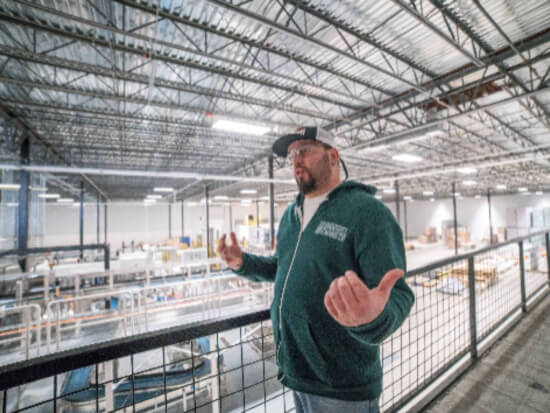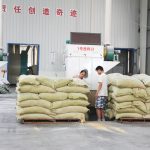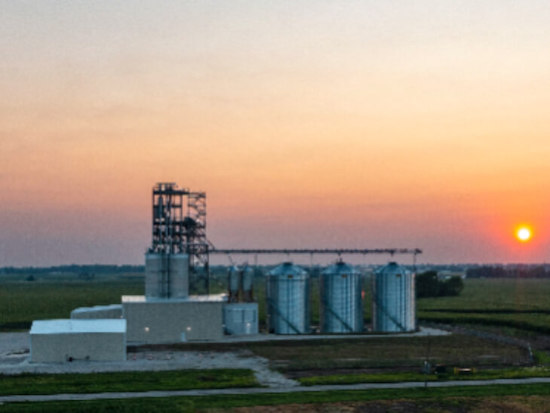The mechanical equipment process of the fully automatic feed production line is composed of cleaning, crushing, batching, mixing, granulating, packaging and other systems. Each system has a number of equipment and devices. The front and rear systems and the equipment in the front and rear processes are almost all connected mechanically. Since they can be arranged in different arrangements and combinations, a variety of process flows have emerged.

The characteristic of the technological process of large-scale feed processing machinery is that during the entire production process from raw material input to finished product output, materials are processed in a closed state, similar to grain processing, but more complicated than the technological process of grain processing. This is because the latter processes a single type of material, while the former processes a variety of materials, and there are stricter ratio requirements between different types of materials.
Reasonable process flow can give full play to the production efficiency of complete sets of feed machinery and equipment and improve the technical and economic indicators of the entire plant, so it is valued by people. However, the design of the feed processing production line process is not easy. It involves many issues and a wide range of knowledge. In summary, it can be measured from the following aspects, namely: adaptability of processing materials, rationality of supporting complete sets of equipment, compactness of equipment layout, technical and economic indicators, and safety and reliability of operations. Among the many processes of feed processing equipment, crushing is the heart, metering is the key, and mixing is the guarantee.
Fully automatic feed production line machinery and equipment process flow:
Raw materials → feed grinding → feed mixing → feed pelleting → pellet cooling → pellet crushing → screening and grading → pellet packaging
The above process can also add or reduce equipment functions according to customer needs.
Batching process: The raw materials in the batching bin are weighed from the feeder under each batching bin to the batching according to the formula requirements. After each raw material is weighed by the batching scale, the raw materials are transported to the powder storage bin. The ingredients are weighed out from the silo. These weighed raw materials enter the powder silo. A small amount of materials and premixes are added and directly weighed manually and then put into the silo for mixing. The quality of the batching process directly affects the accuracy of product batching.

Grinding process: refers to sending the raw materials to be crushed in the silo to the crusher and crushing them into powder, and then sending them to the silo for mixing by the conveyor before use. The purpose of this process is to control the particle size of the material. The design efficiency of the crusher in this process determines the production capacity of the process equipment, and is also the energy consumption process in the production of powdered materials. Check and confirm the hammer, screen, current, noise and grinding path.
During the mixing process, various crushed raw materials are discharged from the mixing chamber into the mixer, and oil is added to the feed in the mixer through the liquid addition system as needed to mix the components evenly and achieve the required mixing effect. Uniformity, The material discharged from the mixer is the finished product, which is directly sent to the packaging process of the finished product for packaging and shipment. When producing pellet feed, the mixed powder is sent to the silo for granulation. In order to ensure the efficiency of the mixer, maintenance personnel must regularly inspect and repair the equipment and regularly test the efficiency of the mixer.
After the mixed materials are magnetically separated and conditioned from the granulation bin, they are sent to the compression chamber of the granulator, compressed into pellet feed, cooled by the cooling tower, and screened by screening equipment to obtain standard granules. Magnetic separation equipment must be cleaned regularly to prevent iron impurities from causing damage to the granulator. When conditioning, the amount of steam should be adjusted according to the requirements of the particle variety, and the ring mold (pore diameter, compression ratio, material, etc.) should be selected according to the particle process quality requirements. During cooling, the cooling tower should be adjusted according to the variety, indoor temperature and humidity, season and other factors to achieve qualified results, particle temperature and humidity. Adjust the cooling tower according to factors such as variety, indoor temperature and humidity, season, etc. to achieve qualified particle temperature and humidity.
The feed is weighed from the finished product warehouse through a packaging scale, put into packaging bags, and then the packer inserts the label and seals it, and then is transported to the warehouse by a transport truck for stacking.





